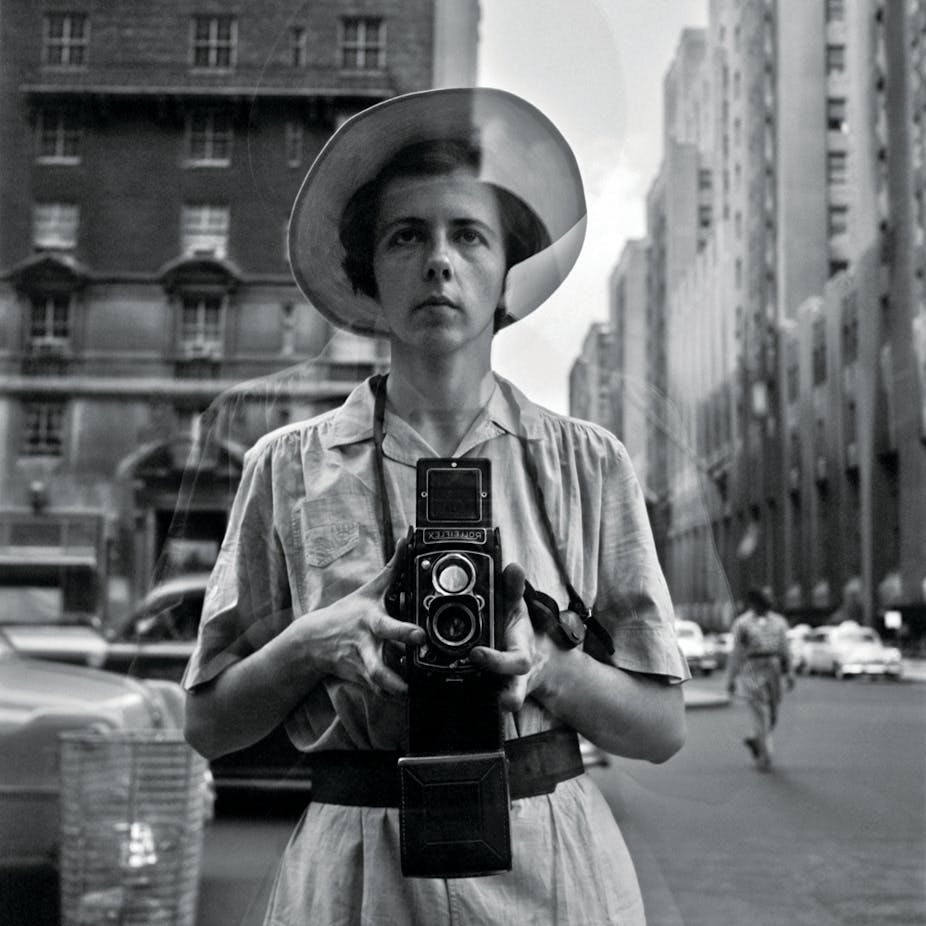The Melbourne Festival is running two events dedicated to the recently-discovered American street photographer Vivian Maier. One is the exhibition at the Centre for Contemporary Photography, Crossing Paths with Vivian Maier. The second is John Maloof and Charlie Siskel’s documentary Finding Vivian Maier, currently screening at the Australian Centre for the Moving Image (ACMI).
Maloof and Siskel’s documentary tells two stories. The first recounts how amateur historian John Maloof “found” a box of Vivian Maier’s photographic negatives completely by accident in 2007. The second details Maloof’s search for Vivian Maier in a figurative sense – that is, his attempt to gain a better understanding of who she was.
Here is a summary of the first story: in 2007, Maloof bought a box of undeveloped negatives at an auction in Chicago for US$380. When he finally got around to scanning the negatives two years later, he discovered a striking collection of 1950s-era photographs. They showed atmospheric city streetscapes and audacious portraits of urban dwellers. Some of them depicted a slightly stern, slightly whimsical looking woman taking self-portraits in mirrors and shop windows.
It took some time to identify the photographer. Finally, receipts inside the box revealed her name: Vivian Maier. When Maloof undertook a Google search in April 2009, he found that she had died just a few days earlier.
After tracking down and processing Maier’s other negatives, Maloof organised an exhibition of her work at the Chicago Cultural Centre. It was incredibly well-received, and Maier is now internationally recognised as a street photographer.
The second story of Finding Vivian Maier concerns Maloof’s quest to learn more about the mysterious woman who took the photographs. It is this search that takes up the bulk of the documentary.
By interviewing people who knew Maier when she was alive, Maloof discovered that Vivian was a single woman who worked almost her entire life as a nanny for affluent families from the 1950s onwards. She grew up in France and her chief hobby was photography (she took approximately 100,000 photographs, mostly on a Rolleiflex camera). She was also an obsessive collector who hoarded hats, receipts and newspapers. She died in poverty at the age of 83.
Finding Vivian Maier is a film animated by a curiosity about the nature of “the artist”. Cinephiles call this phenomenon “auteur desire” — the term describes both our inquisitiveness about authors’ personalities, as well as our habit of looking for evidence of this personality in the artworks they create.
Finding Vivian Maier effortlessly instills such fascination. Maier’s former charges make for charming interview subjects, and their recollections portray their nanny as a truly eccentric individual.
Apparently Maier liked to go on photographic expeditions around the rougher parts of Chicago, dragging the bewildered children along behind her. She had few friends and no known romantic partners or family. She also went by several different names and, according to an expert in linguistics, spoke in a fake French accent. Most of all, she loved taking photographs, but printed virtually none of them.
Siskel and Maloof’s documentary paints a portrait of an undeniably creative individual. The film has a lightness that seems entirely appropriate for a woman who liked to take pictures of construction workers’ muddy backsides (amongst other unconventional things).
But the documentary never really questions its consuming desire to “find” Vivian Maier. Why does her persona matter so much? Why are we compelled to interpret her work through her life story?
Looking at Maier’s photos on display at the Centre for Contemporary Photography, there is certainly a gregariousness and egalitarianism in her work that is easy to interpret as evidence of an underlying personality. Maier’s Rolleiflex camera stares freely at whatever catches its interest: poor men with bulbous noses, well-heeled women in party dresses, and gurning street urchins.
Maier’s photos reveal a disregard for class barriers, as if they were arbitrary rules that affect only the costumes that people wear. Perhaps, as a European-raised woman working for the affluent classes, Maier had an outsider’s appreciation of American society and its pretensions.
But this is only conjecture. Maier did not curate her own body of work. She no longer has the chance to explain herself as artist, and a stranger now holds the rights to her work. Caught up in its tale of a bohemian nanny, Finding Vivian Maier neglects some of these spikier issues.
Also, perhaps Maier’s biography does not even matter that much to her artwork. One of the most arresting moments in Finding Vivian Maier has little to do with the nanny’s life story. At one point Maloof exhibits Maier’s work in her childhood home of Saint-Julien-en-Champsaur. A very elderly woman looks at a photograph of a man in a flat cap, and her middle-aged daughter says: “You recognise him well, right mum? … He was your husband!”. We don’t need to be told that the gentleman is long departed.
Finding Vivian Maier is an intriguing story about a woman who created art compulsively and secretly, never seeking the recognition that Maloof and Siskel cultivate for her. But it is also a film about the creative power of photography. The moment at Saint-Julien-en-Champsaur is a reminder that photographs are extensions of our memory. Sometimes it is the person in front of the lens who matters most.
Crossing Paths with Vivian Maier is on display until October 26. Details here.
Finding Vivian Maier screens at ACMI until October 23. Details here.

